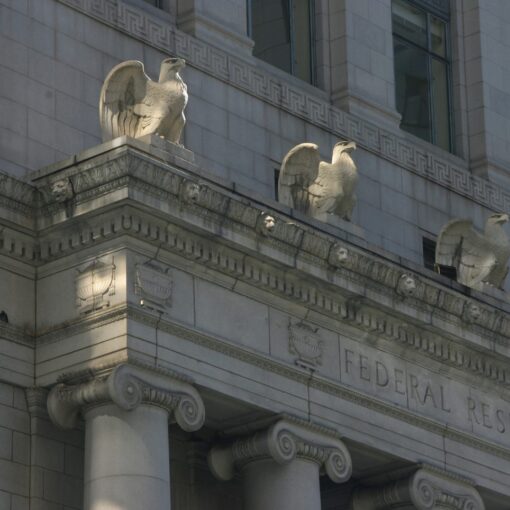[ad_1]
A version of this article originally appeared on the Research Affiliates website.
The current economic environment is a confusing one. Job growth is strong, yet reports of layoffs at high-profile companies are ubiquitous. The yield curve is inverted, implying an imminent recession, but the stock market is at or near record highs.
What can we make of these contradictory signals? Can the economy achieve the hoped-for soft landing of slower economic growth or a mild recession? Or is a hard landing and a regular or even severe recession inevitable?
Provided the US Federal Reserve awakens from its slumber and certain other mitigating factors persist, I believe we can still stick the landing. But many pieces have to fall into place.
The inverted yield curve casts a long shadow. I unveiled this economic growth and recession indicator in my dissertation many years ago. Since the 1960s, it has anticipated eight out of eight recessions and has yet to send a false signal.
Measured as the difference between the yields of the 10-year Treasury bond yield and the three-month Treasury bill, the yield curve inverted in November 2022, leading many to expect a recession in 2023. When none materialized, some concluded that the yield curve had sent a false signal.
That judgment was premature. Over the last four cycles, an inverted yield curve has given, on average, 13 months’ advance warning of a recession. The yield curve inverted only 16 months ago, which is not that far off the mean. Furthermore, over the last four cycles, short rates have fallen back to their “normal” position below long rates — that is, the yield curve “uninverts” — before the recession begins. That uninversion has yet to occur.
Given the yield curve’s track record, we ignore it at great peril. It now indicates growth will substantially slow in 2024 and may or may not lead to recession. Even in a soft-landing scenario, a minor recession is possible. That has happened twice before, in 2001 and from 1990 to 1991, with GDP drawdowns around 1%, as shown in the following chart. The key is to avoid a deep recession like the one associated with the global financial crisis (GFC).
Total GDP Decline in Recession, Peak to Trough

The US economy delivered 2.5% real GDP growth in 2023 and expanded at a 3.3% rate in the fourth quarter. I expect much slower growth in the first and second quarters in 2024 because of four headwinds in particular:
Four Headwinds
1. Consumer Behavior
Personal consumption expenditure is the most critical component of GDP, representing 68% of overall growth. Consumer spending drove much of the 2.5% year-over-year (YoY) expansion in real GDP in 2023. Combined personal consumption and government spending accounted for 87% of that growth. What explains this strength? During the pandemic, consumers amassed $2.1 trillion in excess savings, according to the Fed, so there was considerable pent-up demand as well as generous government support programs. Consumers have been drawing these savings down, which fueled their 2023 spending binge.
Investment is another key aspect of GDP, and it did not benefit from such government support. In fact, with negative YoY investment in 2023, it may already be in a recessionary state.
The leading indicators of consumer savings are important to watch. When savings run out, spending contracts. Consumer loan delinquencies, for example on autos and credit cards, is an intuitive metric. Consumers will only borrow on credit cards with rates in the 20% range when their savings have run dry. Delinquencies have been trending upward, signaling that consumers have depleted much of their savings. Other technical factors also come into play. In October 2023, the pandemic-era pause in student loan repayments ended, and roughly 40 million Americans had to begin repaying this debt directly out of their disposable income.
2. Credit Conditions
The largest banks offer only a few basis points in annual interest on savings deposits. The average savings rate is about 0.5% and skewed by somewhat higher rates at small and regional banks. It may not receive much attention, but this indicates bank weakness and is bad news for the economy.
Consumers can move their savings into money market mutual funds (MMMFs) and easily receive a 5% rate of return. Capital is flying from savings accounts to ultra-safe MMMFs. This has two implications:
- As assets move to MMMFs, banks have less to lend. While the effect is not immediate, credit conditions should tighten this year. That means lower spending by consumers and businesses and, as the cost of capital rises, reduced business investment.
- Many consumers will not transfer their assets to MMMFs. Some don’t know that their savings account interest rate is so low, and others have small balances that might not qualify for MMMFs or enhanced savings rates. These consumers suffer as the value of their modest assets erodes because their savings rates are so much lower than the current rate of inflation.
Yield Disequilibrium

3. Commercial Real Estate (CRE)
COVID-19 structurally changed the nature of work in the United States. We now live in the era of remote and hybrid work, of work from home (WFH). Public transportation use plummeted during the pandemic and then recovered somewhat but has yet to return to pre-COVID-19 levels. Indeed, the data are flattening out well beneath where they were in early 2020, which is consistent with a structural change.
New York Metropolitan Transportation Authority (MTA): Daily Ridership Decline Relative to Pre-Pandemic Equivalent Day

San Francisco, among other cities, has enormous office vacancy rates. The commercial real estate (CRE) market will be a big story in 2024. While the sector had problems in 2023, the media didn’t pay much attention — probably because the loans were not coming due — but they will soon. Refinancing will be necessary this year. This poses a risk to banks, CRE’s principal financiers. The recent plunge in the value of New York Community Bancorp is just one indication of the stress regional banks are under.
4. Interest Service Obligations on Government Debt
Interest service on the net government debt is already more than $700 billion, but the average interest rate on that debt is only 3.11%. Since short rates are at 5% and long rates over 4%, we can reasonably expect that the average interest rate on government debt will spike in 2024 as the government both rolls over existing debt and finances the current large deficit.
I forecast that federal debt service will become the second largest government expenditure category this year, surpassing Medicare and defense spending. We are effectively borrowing to pay interest — which is never a good idea. The ballooning debt and debt service put upward pressure on long rates and thereby impede business investment and economic growth.
But the news isn’t all bad. There are three important mitigating factors that should greatly reduce the likelihood of a deep recession:
Three Tailwinds
1. Excess Labor Demand
There are more job openings than there are job seekers. In March 2022, the gap was an astonishing six million. That gap has shrunk, consistent with slowing growth, but still stands at roughly 2.5 million. So even if growth sputters, there is a buffer before unemployment starts causing a problem. When people are laid off, they sharply cut their consumption spending. But unemployment is a lagging indicator of recession and is always low before it rises during a recession. Either way, excess demand for labor reduces the risk of a disruptive surge in unemployment.
2. Housing
Before the GFC, consumers and banks were highly levered. The amount of equity in the average house was almost equal to the mortgage debt. As housing prices decreased, foreclosures and fire sales spiked and fanned the flames of the recession, making the downturn the most severe since the Great Depression. The housing market is different today. Consumers and banks have substantially more equity than debt. This means that even if a slowdown in 2024 sparks a fall in housing prices, it probably won’t wreak foreclosure-led havoc.
3. The Prophylactic Impact of the Yield Curve
The yield curve inversion is hard to ignore and has to be taken seriously. In fact, when I wrote my dissertation, the theory suggested that the yield curve reflected expectations of economic growth. Today, it is different. As my colleague Rob Arnott often emphasizes, the yield curve now causes economic growth. When businesses see an inverted yield curve, they take preventative action. It is not the time to bet the firm on a new, debt-financed expansion.
So, what happens? Businesses invest less — as occurred last year — and conduct small-scale, 5% to 10%, labor force reductions, as occurred in 2023 and is continuing in 2024. This leads to slower economic growth and is the mechanism that makes the yield curve causal. Companies that grow leaner have a much better chance of surviving an economic slowdown. Such risk management dampens the volatility of the business cycle, which is a good outcome.
The Fed Is the Risk
The Fed started raising rates much too late. It kept rates near zero for far too long post-GFC, amid the longest expansion on record, and despite low unemployment, robust economic growth, and a skyrocketing stock market. That does not seem right.
More recently, the Fed missed the inflation surge, mistakenly dismissing inflation as “transitory.” I said then that Fed was misreading the data. Shelter is the most important component of both the CPI and the Fed’s favorite gauge, the Personal Consumption Expenditure (PCE) deflator, and accounts for 35% of CPI and 40% of PCE deflator. But shelter inflation is measured using something called “owner’s equivalent rent” post-1982 rather than real-time housing prices and rental rates. This calculation operates with a lag. It is like imposing a long moving average on the data. So, when rental inflation reached double digits, it was obvious that a surge in CPI was inevitable — it was just a matter of time.
US Federal Reserve Overshooting

The Fed finally caught on and began a tightening cycle that was, relative to long-term rates, unprecedented in both speed and scale. But again, the Fed misread the data. On 4 January 2023, based on my analysis of real-time data, I concluded that inflation was under control and strongly encouraged the Fed to stand down on rate hikes.
The 12 March CPI print of 3.2% YoY is well above the Fed’s target rate. But that figure is skewed by 5.7% shelter inflation. The rate of shelter inflation does not reflect reality. Surveys report YoY rents at –2%. If we assume that shelter inflation is running at a conservative 2% and recalculate the CPI, YoY inflation is only 1.8%, well below the Fed’s target. In fact, through most of 2023, inflation was in the Fed’s comfort zone.
Policy should be based on real-time data — not obsolete relics. The Fed raised rates by 1% in 2023, justifying each hike with a false narrative that inflation remained high. Inflation was only high because of the antiquated way the Bureau of Labor Statistics calculates it. Yes, shelter inflation was elevated based on conditions 12 months before. But the data were stale.
By overshooting, particularly in 2023, the Fed increased the risk of a deeper recession. It must undo the damage and reverse course. It should start cutting rates immediately and reduce the Fed Funds rate from 5.25% today to 3.5% by year-end.
The Fed failed to act in its January meeting. In its official statement, it cited “inflation risk” an extraordinary eight times. In its meeting later this month, the Fed will likely say it discussed reducing rates but decided to wait until its May or June meetings before taking action — and the action will be 25 bps.
The wait, wait, wait, drip, drip, drip strategy makes a recession much more likely. The Fed needs to take decisive action. It would be nice to hear the Fed say something like:
“We admit we were late to begin hiking rates in 2022, and our new analysis of inflation data suggests that we pushed too far in 2023. As a result, we are cutting rates immediately by 50 basis points, and we are actively considering additional cuts in the near term.”
But as refreshing as this would be, the Fed probably won’t say anything of the kind. Nevertheless, the key to the soft landing is in the Fed’s hands. The sooner it begins easing, the better its chances.
Growth Should Be the Objective
A recession in 2024 would be a self-inflicted wound caused by our policymakers. There is much to like about the medium-term outlook. Once again, the United States is at the forefront of innovation — of artificial intelligence (AI) and decentralized technologies, in particular — that could put us on the path to higher growth.
Yes, serious structural challenges remain. Government debt must eventually be repaid or refinanced. Raising taxes is one option, but that is toxic to growth. Simply printing money to pay off the debt is another recourse. Of course, that would be highly inflationary, which would be as bad as a tax hike and similarly detrimental to growth.
The best way out of our current situation is through growth and by creating an environment where innovation thrives. Tax revenue increases in an expanding economy. Policymakers and regulators must not fumble on these once-in-a-generation innovations. We don’t want our best ideas to move offshore. If that happens, the outlook will darken.
We can still achieve the Goldilocks scenario. If the Fed cuts rates this year, we can dodge the bad recession and settle for slower growth or perhaps a trivial recession. But there is too much focus on the Fed and the short-term prospects. We need to look beyond. We have grown accustomed to 2% growth. Indeed, 2.5% growth in 2023 was welcomed. We have lost our ambition.
In the past, we have achieved 5% growth. Instead of expending our energy trying to guess the Fed’s next move, let’s change the conversation: What do we need to do to accelerate US growth to 5%. Let’s refocus on that.
If you liked this post, don’t forget to subscribe to Enterprising Investor and the CFA Institute Research and Policy Center.
All posts are the opinion of the author. As such, they should not be construed as investment advice, nor do the opinions expressed necessarily reflect the views of CFA Institute or the author’s employer.
Image credit: ©Getty Images / MauritsVink
Professional Learning for CFA Institute Members
CFA Institute members are empowered to self-determine and self-report professional learning (PL) credits earned, including content on Enterprising Investor. Members can record credits easily using their online PL tracker.
[ad_2]
Source link











 Bitcoin
Bitcoin  Tether
Tether  XRP
XRP  USDC
USDC  Dogecoin
Dogecoin  Lido Staked Ether
Lido Staked Ether  LEO Token
LEO Token